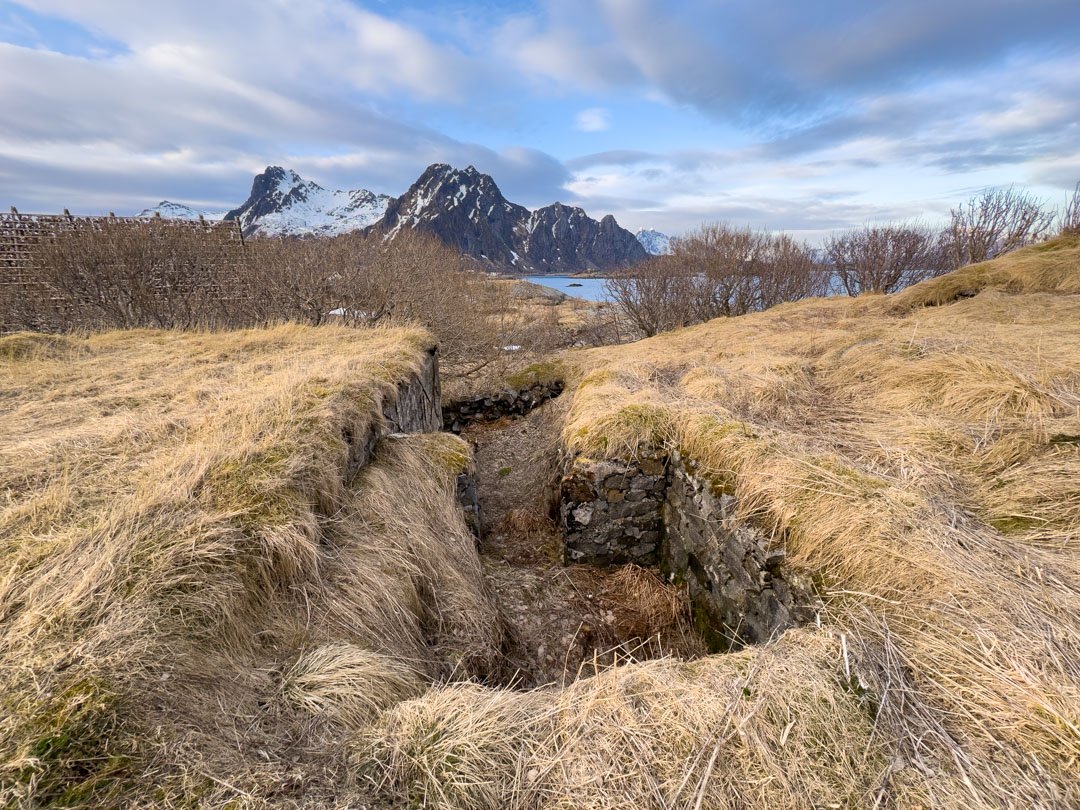Exploring World War II Heritage in Lofoten
In the picturesque landscapes of Norway's Lofoten archipelago lies a hidden layer of history that echoes World War II's tumultuous events. Join us on a journey through time as we uncover the remnants of war and its enduring legacy in this remote corner of the world. Control of the Lofoten Islands during WWII was a priority for Axis Forces due to its strategic location, making it perfect for strategic bases that aid with intelligence and reconnaissance and abundant natural resources - fish! The strategic location of Lofoten is so important that NATO still operates here today, monitoring the North Atlantic alongside the GIUK gap.
Ruined Gun Placements and Relics of Conflict
Scattered across Lofoten's rugged terrain are remnants of World War II in the form of ruined Nazi gun placements, bunkers, and fortifications. These silent sentinels witness Lofoten's strategic importance during the war and serve as poignant reminders of the sacrifices made by those who fought here.
German Tourists and Family Connections
Interestingly, German tourists were among the first to return to Lofoten after the war, drawn by the breathtaking views and landscapes their relatives described during the conflict. For many, visiting Lofoten was a way to reconnect with their family's wartime experiences and pay tribute to the beauty that had provided solace amidst the chaos of war.
Naval Maneuvers and Cat-and-Mouse Games
During World War II, Lofoten was a key battleground for naval forces engaged in a cat-and-mouse game. German naval vessels prowled the fjords in search of Allied convoys, while British and Norwegian resistance fighters staged daring raids to disrupt enemy operations and gather intelligence. Lofoten's rugged coastline and labyrinthine fjords provided the perfect backdrop for these high-stakes naval manoeuvres.
Connections to Kiruna and Natural Resources
The significance of Lofoten during World War II extended beyond its strategic location; it was also linked to the nearby mining town of Kiruna, Sweden. As a significant iron ore producer, Kiruna played a crucial role in supplying the war effort. Lofoten's fjords were vital shipping lanes for transporting this valuable resource to Germany.
Keeping History Alive
As you explore the stunning landscapes of Lofoten, look for the hidden remnants of World War II. From ruined battlements perched on rocky cliffs to rusting gun placements hidden amidst the rugged terrain, these artefacts offer a tangible connection to the past and a reminder of the resilience of the human spirit in the face of adversity.
In exploring Lofoten's World War II history and to get the photos for this post, I walked from Svinøya to Moloen, uncovering significant remnants of the conflict. The fish racks, essential for drying fish, stand above several discreet bunkers and gun placements, but one particular behemoth rises high above the fish racks themselves.
Among the landmarks I encountered on this walk was the fiskerkuna statue, a poignant symbol of Lofoten's deep-rooted maritime heritage. Positioned against the dramatic scenery of mountains and sea, the statue stands as a testament to the sacrifices made by fishermen and the enduring connection between the people of Lofoten and the sea.
As we wander through the breathtaking beauty of Lofoten, let us not forget the history beneath the surface. World War II may have left scars on this remote corner of the world, but it has also left a legacy of courage, sacrifice, and resilience. By exploring the remnants of war and honouring the memories of those who fought here, we ensure that their stories will continue to be told for generations to come.
To learn more about World War II History in Lofoten, visit the Krigsminnemuseum in Svolvær. The Krigsminnemuseum, or War Memorial Museum, in Lofoten, Norway, is a solemn testament to the region's wartime history and sacrifices during World War II. Located in Svolvær, this museum offers visitors a comprehensive insight into the events that unfolded in Lofoten during the war years.
As visitors step inside the museum, they are greeted by exhibits that chronicle the occupation of Norway by Nazi forces and the resistance efforts that ensued. Artefacts, photographs, and personal accounts vividly depict life under occupation, showcasing the challenges faced by the local population and the courage displayed by those who fought against oppression.
One of the museum's highlights is its collection of artefacts related to the daring Operation Claymore, a British commando raid launched on the Lofoten Islands in 1941. Visitors can explore displays detailing the raid's planning, execution, and impact on the war's course.
In addition to its historical exhibits, the Krigsminnemuseum serves as a place of reflection and remembrance. Through its immersive exhibits and poignant displays, the Krigsminnemuseum offers visitors a deeper understanding of Lofoten's wartime past and the enduring legacy of courage and sacrifice that resonates today.




